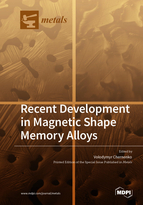Recent Development in Magnetic Shape Memory Alloys
A special issue of Metals (ISSN 2075-4701). This special issue belongs to the section "Entropic Alloys and Meta-Metals".
Deadline for manuscript submissions: closed (31 October 2021) | Viewed by 23633
Special Issue Editor
Interests: magnetic shape memory materials; martensitic transformations; magnetocaloric and elastocaloric effects; thin films and nanotechnologies of the magnetic martensites
Special Issue Information
Dear Colleagues,
Metals is launching a new Special Issue entitled “Recent developments in magnetic shape memory alloys.” The Special Issue will provide a platform for presenting the latest experimental and theoretical results in the innovative field of the magnetic shape memory alloys exhibiting giant magnetostrain, magnetocaloric, elastocaloric, and magnetoresistance properties, and other unusual “structure – magnetism” behaviors on the different scales.
I would be delighted if you would be willing to contribute an original or review article to this issue.
Prof. Dr. Volodymyr Chernenko
Guest Editor
Manuscript Submission Information
Manuscripts should be submitted online at www.mdpi.com by registering and logging in to this website. Once you are registered, click here to go to the submission form. Manuscripts can be submitted until the deadline. All submissions that pass pre-check are peer-reviewed. Accepted papers will be published continuously in the journal (as soon as accepted) and will be listed together on the special issue website. Research articles, review articles as well as short communications are invited. For planned papers, a title and short abstract (about 100 words) can be sent to the Editorial Office for announcement on this website.
Submitted manuscripts should not have been published previously, nor be under consideration for publication elsewhere (except conference proceedings papers). All manuscripts are thoroughly refereed through a single-blind peer-review process. A guide for authors and other relevant information for submission of manuscripts is available on the Instructions for Authors page. Metals is an international peer-reviewed open access monthly journal published by MDPI.
Please visit the Instructions for Authors page before submitting a manuscript. The Article Processing Charge (APC) for publication in this open access journal is 2600 CHF (Swiss Francs). Submitted papers should be well formatted and use good English. Authors may use MDPI's English editing service prior to publication or during author revisions.
Keywords
- ferromagnetic shape memory alloys
- metamagnetic shape memory alloys
- martensitic transformation
- magnetocaloric effect
- elastocaloric effect
- heusler alloys






